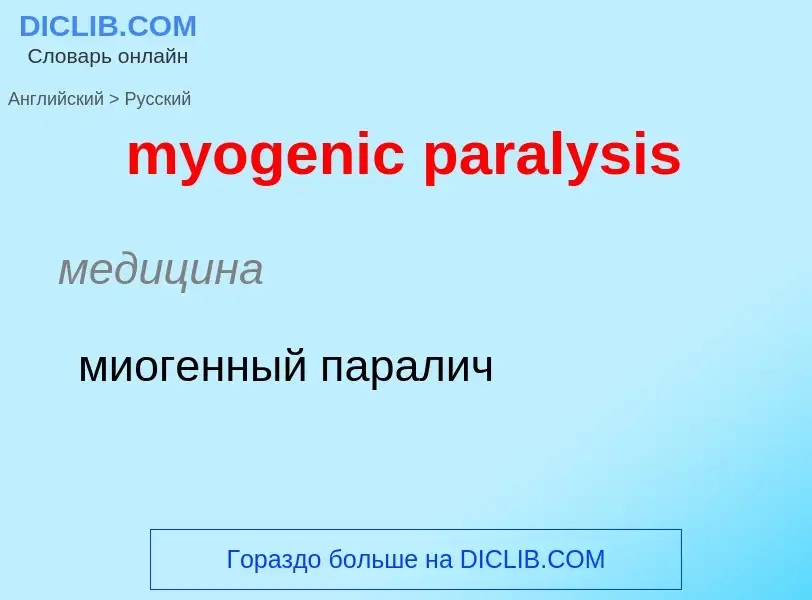Tradução e análise de palavras por inteligência artificial ChatGPT
Nesta página você pode obter uma análise detalhada de uma palavra ou frase, produzida usando a melhor tecnologia de inteligência artificial até o momento:
- como a palavra é usada
- frequência de uso
- é usado com mais frequência na fala oral ou escrita
- opções de tradução de palavras
- exemplos de uso (várias frases com tradução)
- etimologia
myogenic paralysis - tradução para russo
медицина
миогенный паралич
медицина
периодический паралич
медицина
эпизодическая наследственная (эпизодическая семейная) адинамия
Definição
Wikipédia
The myogenic mechanism is how arteries and arterioles react to an increase or decrease of blood pressure to keep the blood flow constant within the blood vessel. Myogenic response refers to a contraction initiated by the myocyte itself instead of an outside occurrence or stimulus such as nerve innervation. Most often observed in (although not necessarily restricted to) smaller resistance arteries, this 'basal' myogenic tone may be useful in the regulation of organ blood flow and peripheral resistance, as it positions a vessel in a preconstricted state that allows other factors to induce additional constriction or dilation to increase or decrease blood flow.
The smooth muscle of the blood vessels reacts to the stretching of the muscle by opening ion channels, which cause the muscle to depolarize, leading to muscle contraction. This significantly reduces the volume of blood able to pass through the lumen, which reduces blood flow through the blood vessel. Alternatively when the smooth muscle in the blood vessel relaxes, the ion channels close, resulting in vasodilation of the blood vessel; this increases the rate of flow through the lumen.
This system is especially significant in the kidneys, where the glomerular filtration rate (the rate of blood filtration by the nephron) is particularly sensitive to changes in blood pressure. However, with the aid of the myogenic mechanism, the glomerular filtration rate remains very insensitive to changes in human blood pressure.
Myogenic mechanisms in the kidney are part of the autoregulation mechanism which maintains a constant renal blood flow at varying arterial pressure. Concomitant autoregulation of glomerular pressure and filtration indicates regulation of preglomerular resistance. Model and experimental studies were performed to evaluate two mechanisms in the kidney, myogenic response and tubuloglomerular feedback. A mathematical model showed good autoregulation through a myogenic response, aimed at maintaining a constant wall tension in each segment of the preglomerular vessels. Tubuloglomerular feedback gave rather poor autoregulation. The myogenic mechanism showed 'descending' resistance changes, starting in the larger arteries, and successively affecting downstream preglomerular vessels at increasing arterial pressures. This finding was supported by micropuncture measurements of pressure in the terminal interlobular arteries. Evidence that the mechanism was myogenic was obtained by exposing the kidney to a subatmospheric pressure of 40 mmHg; this led to an immediate increase in renal resistance, which could not be prevented by denervation or various blocking agents.


